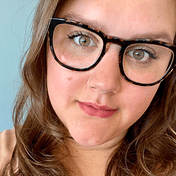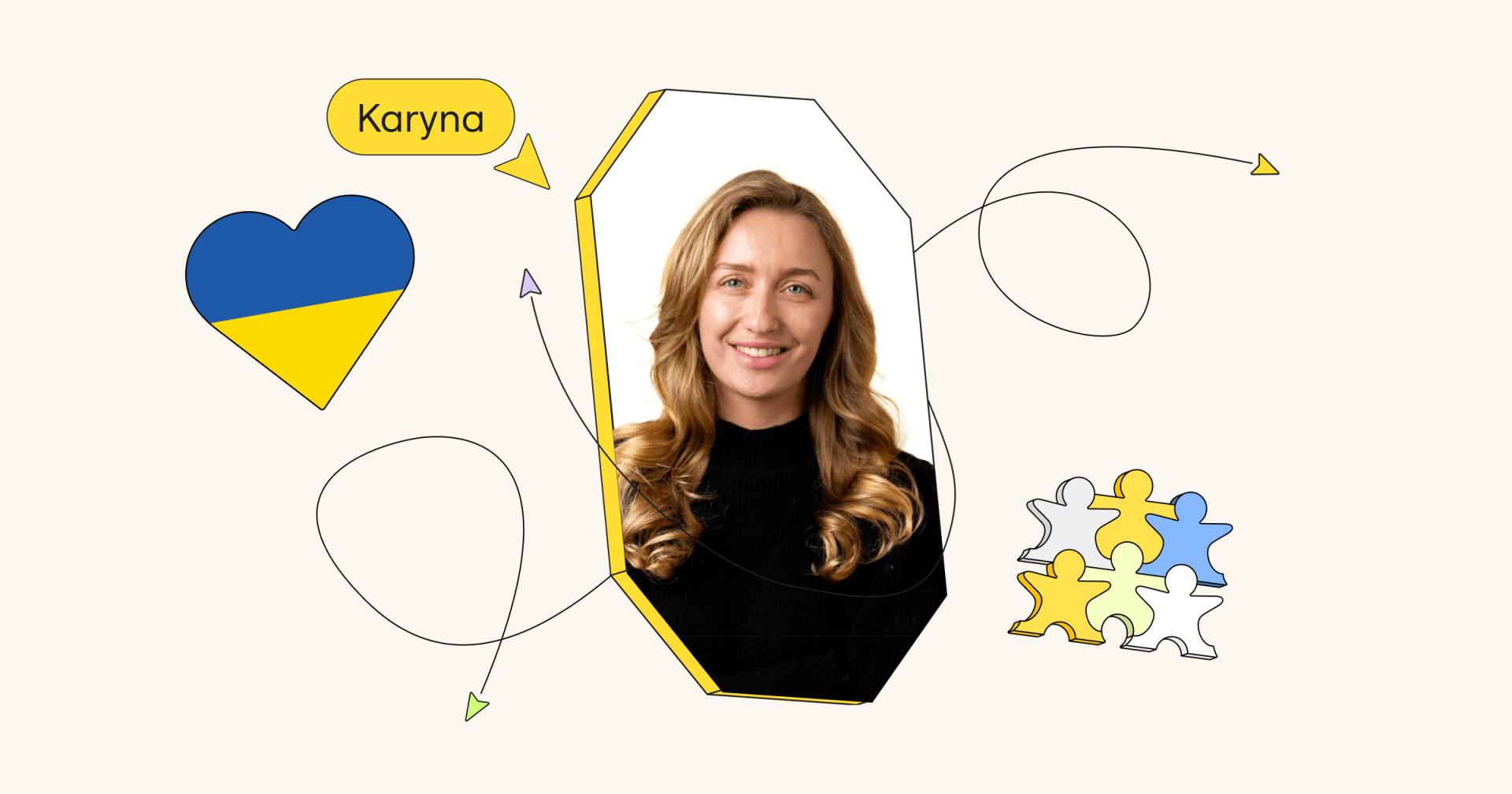When you’re building a globally beloved tool across time zones, countries, and teams, finding ways to come together can prove to be a real challenge. For all that Slack channels and weekly team meetings on Zoom can do to encourage innovation, collaboration is sometimes the casualty in an office culture where most teams are never in the same location at the same time. Without working on common projects, getting to know people outside our immediate team structures becomes even more challenging.
But for the team behind Miro’s hybrid hackathons, those challenges are all part of the magic.
“The hackathon is my favorite event that we do as a company,” says Bianca Genova, Miro’s Global Culture and Events Manager and a Hackathon Planning Team member. “It’s crazy, but it’s also super fun. It brings together so many different people and brains and ways of thinking and priorities.”
Miro employees fill an open-concept office space, collaborating together on a project
This past February, Mironeers in 9 different hubs on 46 teams came together across functions for the first hackathon of the year to pitch 37 completed projects, competing joyously to explore the art of the possible. While some of the winning pitches from previous Hackathons eventually become official Miro features (emoji reactions and sticky note recognition are just two examples), the ultimate goal of a hackathon at Miro is to collaborate and drive ideation.
“It’s a great way to incentivize collaboration between people who don’t normally work together,” says Head of Product Excellence and Hackathon Planning Team member Anna Boyarkina. “When you’re able to get a huge amount of work done in a few days, you get a surge of dopamine, and when you can switch roles to something you don’t normally do, it inspires creativity.”
So how exactly does a global, distributed company of 1,800+ pioneers working across 8 time zones successfully pull off a hybrid hackathon? By designing for impact, building for possibility, collaborating beyond comfort zones, and letting passion pave the way.
Designing for impact
A Miro hackathon represents a huge effort on the part of every participant, from planning team member down to pitch presenter. Participants are asked to work far outside their normal functions. Customers are pulled in to help with some of the judging. Even the logistics of building the hackathon takes a fair amount of work – and for the most part, it all happens in a virtual space. The event portion of Miro’s hackathons last 3 days, but the project planning behind it can take months. The planning team work cross-functionally and across time-zones from Amsterdam, Berlin, Austin, and Yerevan. Designing every detail to maximize impact helps bring everyone together to co-create new and exciting work.
Hackathons at Miro are famously fun and beautifully designed, and February 2023’s hybrid hackathon was no different. After much voting, the Hackathon Planning Team felt drawn to an underwater theme, inviting participants to seek the “iceberg problem” hiding below the surface and hack the unknown. Their projects would face three points of judging criteria:
- Impact – Does it demonstrate business value? What’s the feasibility to launch?
- Technical merit – Do you have a working prototype? Are you pushing the limits?
- Creativity and originality – Is it simple? Original? Creative?
A Miro board built for a hackathon using a submarine and aquatic life as its theme
From underwater-themed playlists for all the virtual Zoom hangouts, to underwater-inspired swag and posters, to a submarine as the main image for the Miro board: Everything pointed to diving below the surface and discovering what lies beneath. As Bianca and the planning team discovered, when every aspect of the process sparks joy, the results are bigger, better, and more adventurous.
At the end of the day, it's really important for me that even Maya from our Brand Team, who creates all our assets, really has fun with it. Because I feel like the more excited they are about the theme, the more empowered they feel and the better all of these assets are going to be.
Building for possibility
Hackathons are much easier to accomplish with everyone in person, but here at Miro, the challenge of creating an inspirational hybrid experience has never been something to back down from.
“Ultimately you want to celebrate and make people feel seen,” Anna notes. “So when we plan our hybrid hackathons, we optimize for equal participation and celebrating people’s ideas wherever they are.”
In that spirit, establishing a fair playing field played a major role in structuring the hackathon. From hosting virtual practice pitch sessions and establishing mentor support Slack channels, to incorporating detailed playbooks into the hackathon Miro board, the Hackathon Planning Team incorporated previous feedback to make this year’s hackathon feel more full of possibility than ever before.
A diverse group of Miro employees sit in chairs arranged in an open-plan office, laughing and enjoying a presentation.
The three days of pitching and judging were structured with an even playing field in mind. Teams pitched their projects in individual Zoom rooms without audiences to ensure that each judge wouldn’t be swayed by audience reactions. Having a good internet connection can make or break the flow of a pitch, so participants gathered at their hub offices when possible to ensure everyone had access to the best connection.
Some might consider pulling multiple globally distributed teams, offices, and functions into one big initiative to be an enormous challenge, but as Anna puts it, “That challenge is a celebration of the nature of Miro, which is about collaboration, empathy, and teamwork.”
Collaborating beyond comfort zones
As hackathon participants often discover, anyone can take on any role and still contribute meaningfully to a team, and for Miro’s February 2023 hackathon, that kind of borderless collaboration served as a strong foundation. For three days, across continents, engineers took on the roles of product manager or researcher, product managers with coding skills tried on their engineering hats, and Mironeers on the Customer Experience team brought their impeccable presentation skills to the table. Over 50% of the 46 teams contained members from at least 2 functions spanning the globe, some even using AI to write their first-ever line of code.
Three Miro employees smile at the camera in a hang-out spot in an office. One, a tall man, wears an orange beanie. The other two, a man and a woman, smile and hold up their own orange beanies.
When it comes to building teams and deciding what skills are needed, Miro hackathons prove that everyone has something to offer, no matter where they’re based. Bianca notes that for her, this is the best part of a Miro hackathon. “It’s an authentic learning experience that drives iteration at Miro: You bring to the market these new ideas, and you do it by focusing on what customers want from us while doing something you’ve never done before.”
Letting passion pave the way
At the end of the day, Miro is a tool built by dreamers, builders, and thinkers to help our customers create the next big thing. This means that everything we do is motivated by a passion for people and the problems they face in their daily work lives. During the three long days of building and presenting pitches, Mironeers’ passion never wavered.
Most projects for the hackathon fell into two categories: the Make It Happen track, where Mironeers pitch projects that set up other Mironeers for success, and the Product track, which includes any new product features, adjustments, and ideas. With pitches posted on the official Miro Hackathon board, these tracks helped projects focus on customer-centric questions, such as:
- How can we make cursors on Miro boards more apparent for users who are visually impaired?
- In what ways can Miro broaden its search functionality to compete with search engine innovation?
- How can we improve our users’ experience with the text function on a Miro board?
Up for the taking were six awards, each with themes like the best use of AI and the biggest tech uplift. For the Customer Choice Award, the Hackathon Planning Team enlisted the help of the Sales team to select customers who then served on the judging panel.
At a Miro office party, balloons float through the air like bubbles and a person dressed in a crab suit wades through the bubbles.
Lessons learned from another successful hybrid hackathon
After 3 days’ worth of hacking and a lot of pizza, a panel of 8 judges – led by Miro CEO, Andrey K. – selected 6 ultimate winners, a process celebrated virtually across the world at 4 watching parties. Audiences cheered on their teammates over breakfast in Austin, and with cocktails in Berlin, and while the winning projects are top secret, keep your eyes peeled for any new features that roll out in the next year.
In the meantime, in the months since the hackathon has finished, Mironeers are clamoring for more. “People are already saying, ‘Can we do this more often? Please?’” Bianca laughs.
Planning is already underway for the second hackathon of the year in November. For Bianca, that means incorporating lessons learned about hosting a hybrid hackathon event into the structure of the next one.
Ensuring that this next event is even more inclusive than the last is a top priority. “Everyone has a skill that a team could benefit from,” she says. “We’re thinking about making hackathons that are more focused for people who don’t have coding experience, or even doing specific use case-focused hackathons to help draw in every Mironeer.” Promoting a fair competition also continues to be a focus, as is making sure every participant is onboarded and encouraged appropriately, no matter what their needs may be.
No matter what the theme of the next hackathon, as Bianca puts it: “The possibilities are endless.”




